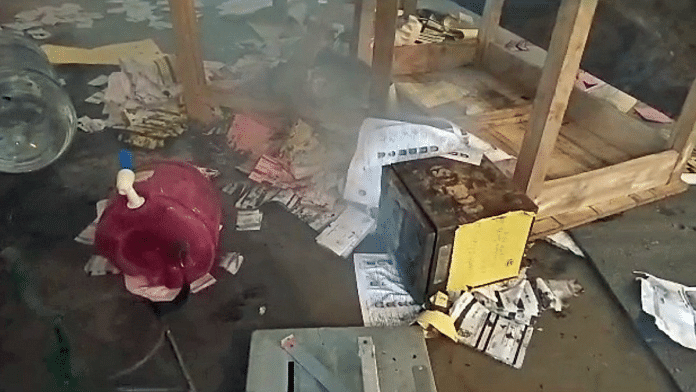The 2023 panchayat elections in West Bengal for the three-tier Panchayati Raj Institutions, Gram Panchayats, Panchayat Samitis, and Zilla Parishads, concluded with the All India Trinamool Congress leading the tally and the Bharatiya Janata Party emerging as the second-largest party in the local body seats. While the BJP has improved its seat and vote count compared to previous elections, the gap between the winner and the runner-up remains significant. The Communist Party of India (Marxist), which once ruled the state for nearly three and a half decades, secured a distant third place, while the Congress had a negligible presence. The Aam Aadmi Party received just one vote, indicating that the main contest in the 2024 Lok Sabha election is likely between the TMC and the BJP.
The Gram Panchayat elections in West Bengal hold great importance for three main reasons, apart from other significant factors. They serve as indicators for the subsequent elections that follow.
In the 2018 panchayat elections, the TMC secured 95% of the Zilla Parishad seats, emerged victorious in 90% of the Panchayat Samiti seats, and won 73% of the Gram Panchayat seats. The BJP won 5,779 seats, garnering an 11.9% vote share. The CPM won 1,483 seats with 3% of the votes, while the Congress won 1,066 seats with a 2.2% vote share. In the 2019 Lok Sabha election, the BJP made massive gains in the state, winning 18 Lok Sabha seats, while the ruling TMC won 22 seats compared to the 34 seats it won in 2014. In the 2021 assembly election, the TMC won 215 seats, while the BJP made substantial progress, securing 77 seats, the same number as the CPM’s tally in the 2016 assembly election. Therefore, the local body polls have become a barometer for the outcomes of the assembly and Lok Sabha elections.
Local bodies hold substantial power and influence over the voters within their jurisdiction. The winning party gains control over the day-to-day life of the people and oversees various aspects of society, including educational institutions and government job allocation. The political opponents are either wiped out or rendered irrelevant, with no connections to the Writers’ Building, the official secretariat of the government.
The 73rd amendment to the Indian Constitution in 1992 created the three-tier Panchayati Raj system, granting significant functional and financial powers to these local bodies. Incidentally, West Bengal scores 5 out of 5 on the functional devolution index but rates relatively lower at 3.68 on the financial devolution index. In 2014, 986 out of 999 Gram Panchayats in West Bengal qualified for a block grant of around Rs 20 lakh each. In 2017, the Chief Minister announced that elected representatives in Gram Panchayats would earn a minimum of Rs 1,500 per month, compared to Rs 150 previously, thereby increasing the pay at every level of the three-tier local bodies. Panchayat heads received a substantial raise, from Rs 2,000 to Rs 3,000 per month.
Additionally, these bodies receive significant budgetary allocations amounting to crores of rupees. With limitless political authority, unrestricted financial resources and muscle power, and complete control over the population, the local body polls become a do-or-die battle. Little wonder then that violence is often the first step towards political and financial power in the state, acting as a gateway to higher political offices.
Also read: Intense focus on Bengal panchayat poll violence swept two things under the carpet
A recurring theme
The scale of violence witnessed during the West Bengal panchayat elections has become a recurring feature of elections in the state. While the recent incidents received wide media coverage and caught the attention of the courts and political parties, the trend of poll violence in West Bengal seems to be a continuation of the historic past. The cycle of violence began as early as Independence in 1947, coinciding with the tragic Partition and the creation of what was then East Pakistan. The All India Muslim League declared “Direct Action Day” on 16 August 1946, with the intention of taking “direct action” to establish a separate Muslim homeland after the British exit from India. Mohammad Ali Jinnah, the leader of the Muslim League, famously proclaimed, “We shall have either a divided India or a destroyed India.” The ensuing violence, known as the ‘1946 Calcutta Killings’ or ‘The Week of the Long Knives,’ resulted in mass killings and massive population transfers, leading to the exodus of Hindus from East Pakistan, now Bangladesh. Since then, both Bengals have witnessed senseless violence.
The political rivalry between the Indian National Congress and the All India Muslim League, each claiming to represent Hindus and Muslims, respectively, not only resulted in killings and violence but also led to the Partition and a permanent political divide. The departure of the British and the Partition created a power vacuum and administrative collapse. The seat of political power was up for grabs, which was eventually occupied by the Congress. West Bengal, like several other states, had an uninterrupted Congress government for about three decades until 1977 when the Left Front, led by the Communist Party of India (Marxist), secured a majority by winning 231 seats, reducing the Indian National Congress to a mere 20 seats.
Violent attacks on political adversaries have been the thumb rule in the state, initially between the Congress and the CPM, followed by conflicts between the CPM and the TMC, and currently between the TMC and the BJP. While political parties have changed over the time, the leaders of street gangs have remained largely the same. In West Bengal, parties hold the belief that political power comes only with the help of the barrel of a gun. Hopefully, the adage “what Bengal thinks today, India thinks tomorrow” will not apply to this belief and the prevalence of mindless political violence.
Seshadri Chari is the former editor of ‘Organiser’. He tweets @seshadrichari. Views are personal.



